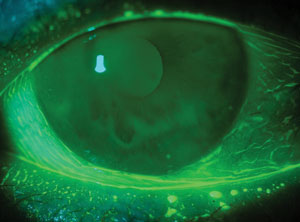 |
| Patients with severe vitamin D deficiencies were found to have worse conjunctival parameters. Photo: Barbara Caffery, OD, PhD. Click image to enlarge. |
Researchers recently found that children with vitamin D deficiency experience significant conjunctival histopathological changes, which can affect some tear function-associated clinical findings including the Schirmer-1 test and tear breakup time (TBUT) measurements.
This prospective case-control study included two groups: one of pediatric patients with vitamin D deficiency (n=38) and another of controls (n=45). TBUTs, Schirmer-1 test measurements, ocular surface disease index (OSDI) scores and conjunctival impression cytology results were compared between groups.
The median TBUTs and Schirmer-1 test measurement were 10 seconds and 12mm in group one and 11 seconds and 15mm in group two. The median OSDI scores were 16 in group one and 17 in group two. According to conjunctival impression cytology, 25 samples in group one and 40 samples in group two were categorized as grade zero, 11 samples in group one and five samples in group two were categorized as grade one and two samples in group one and zero samples in group two were categorized as grade two.
“More important changes in both histopathological and clinical findings occur in more severe vitamin D deficiency,” the study authors wrote in their paper.
Aydemir GA, Ilhan C, Pehlıvanoglu B, et al. Conjunctival histopathological changes in children with vitamin D deficiency. Eye Contact Lens. May 17, 2022. [Epub ahead of print]. |

